6 BEST Facial Recognition Apps & Software (2025)
You may want a facial recognition app to find someone online, do a background check, or look yourself up to prevent the misuse of your images. If you are a photographer or a model, you may also want to use these tools to claim copyright violation fees in case your images are used without a proper license. Concerned parents or guardians who want to protect their minors from being catfished or stop their pictures from being misused by someone online can also use these tools.
However, if you use a facial recognition app, make sure that it respects user privacy. There are also several apps in the market that may not offer accurate results and waste your time by providing undesirable outcomes. Hence, I decided to take up this challenge and look for reliable tools myself. I spent over 130 hours analyzing 40+ apps and finally shortlisted six best facial recognition tools. My comprehensive and transparent review shall take you through their features, how-to section, and pricing. Please read the whole article to find a suitable app for your needs. Read more…
Best Face Recognition Apps & Software: Top Picks!
| Tool Name | Key Feature | Free Trial | Link |
|---|---|---|---|
| 👍 Social Catfish | Searches images from public records, social media, court records, news blogs, and websites | 3-day paid trial for $6.87 | Learn More |
| Spokeo | Searches results various details including address, legal name, family, location, and age. | 7-Days Trial for $0.95 | Learn More |
| Google Images | Includes advanced search option, allows direct search using camera, gathers images from all public forums, including news sites, social media, community networks | Free tool | Learn More |
| Bing Visual Search | Can offer results for elements in an image, looks up all public forums, can find accurate cropped images | Free tool | Learn More |
| TinEye | It can find manipulated images, search all web resources, and identify colors in images with shade percentage | Basic free version | Learn More |
1) Social Catfish
Social Catfish is a robust facial recognition app that includes data from public records, social media, court records, news blogs, and websites. Its additional advantages include people, phone numbers, usernames, and email address lookup services. While testing it, I found mine and other people’s images online, no matter where they appeared.
Social Catfish’s instant search capability also makes it convenient to use anytime. Not only could I find the person I was looking for, but it also gave me a complete report about the individual along with background details. Therefore, law enforcement and recruiters can take help from Social Catfish in case of emergencies.
Pricing:
Here is the pricing for Social Catfish’s facial recognition feature:
| 3-Day Trial | One Month |
|---|---|
| $6.87 | $28.97 |
How to use Social Catfish?
Here is a step-by-step guide on how to use Social Catfish for reverse image searches:
Step 1) Go to https://socialcatfish.com/, select the Image option, upload the image to the search bar, and allow the tool to scan it.

Step 2) Once the scanning is complete, you can enter your email ID and tap on Yes, I Understand.

Step 3) Now, you can get the full report with the target individual’s details.
Advanced Features and Capabilities:
- Social Catfish has 200 billion records in its database. Hence, I received accurate reports for most of my image searches. In my experience, a closeup photo yields faster results.
- The details in its report really made me realize how robust Social Catfish is.

- It is also great for artists and photographers. Hence, if you are concerned about your artwork or professional images being posted online without your consent, you can use Social Catfish to find those source websites. Plus, it has a scammer’s database to help you find out if the image is of a common scammer.

- Moreover, it will help you find forgotten and removed images as well. The best part is that it is entirely anonymous; hence, all my secret investigations remain private.
Limitations and Drawbacks:
- Although Social Catfish offers a complete report, there were times when some of the details, such as addresses or occupations, were missing.
- I looked up my high school friend, who I had lost touch with, but received their outdated contact details. Therefore, I DMed them on social media instead to ask for their number.
- When I tested it with an image that wasn’t front-facing, Social Catfish did scan it but was unable to provide any accurate result.

3-Day Trial for $6.87
Spokeo is the best facial recognition app. Its 12 billion+ records in the database are used to identify individuals and provide relevant information about them accurately. This people search engine unlocks a world of possibilities for both personal and professional use.
2) Google Images
Google Images is one of the simplest yet fastest facial recognition apps. I liked the fact that it is an on-the-go tool that doesn’t require any setup or added details. It has an integrated lens, which lets me simply point to an image and use.
Additionally, it is great for recognizing non-human objects and non-living faces as well. For example, insects, animals, paintings, and statues. I could also use filters, such as visual matches, exact matches, products in the image, about the image, and more.
Pricing:
Google Images is an entirely free tool.
How to use Google Images?
Here are the steps on how to use Google Images for facial recognition:
Step 1) Go to https://images.google.com/, click on the lens, upload or paste a URL, or drag and drop a picture and hit Search. (You can also take a picture with a smartphone.)

Step 2) Once the image is uploaded, it will show similar results along with the details of the person in the image and their other related pictures.


Advanced Features and Capabilities:
- The scanning process is instant; it happens in less than a blink of an eye as soon as the image is uploaded.
- I found links to articles or news related to the person, which helps find details about the target.
- It brings up the subject’s social media links in the results.

- If you want to scan an object separately in the image, Google Images is your answer. For example, an accessory that your favorite celebrity is wearing.
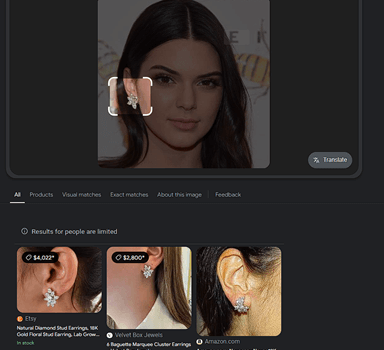
Limitations and Drawbacks:
- One of the most common challenges that I faced while using Google Images is unrelated results. Although not a major drawback the unrelated images might pop up along with correct results.
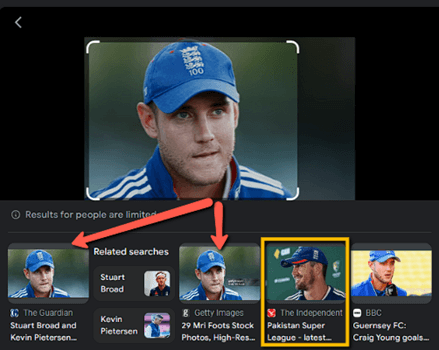
- I couldn’t find people who didn’t have social media or weren’t relatively well known. Unlike Social Catfish, which can offer some details such as associated contact details, Google doesn’t have such capability.
Link: https://images.google.com/
3) Bing Visual Search
Bing Visual Search functions similarly to Google Images in terms of facial recognition. However, I have noticed slight differences in results, which may occur due to different databases.
The main difference between Bing and Google is its ability to take a picture with a computer or laptop’s camera, as well as a smartphone. I also liked its “Find an image” option, which allows you to search for people instantly. It performs the searches without any delay and includes text extraction features from images.
Pricing:
Bing Visual Search is a free tool.
How to use Bing Visual Search?
Here’s how I used Bing Visual Search for facial recognition:
Step 1) Go to https://www.bing.com/visualsearch, drag and drop, paste a URL, or browse an image to upload on the platform.

Step 2) Once uploaded, it gave me the results with images that matched my subject.
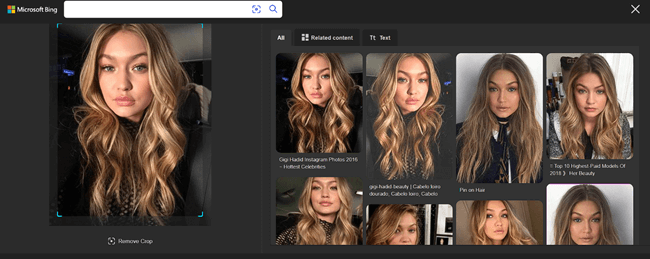
Advanced Features and Capabilities:
- Bing allowed me to find cropped versions of the same image when I used its lens to crop it.

- It lets you identify objects within the image, which is great for people who want to purchase something that they see in a picture. For example, a rug in an image of a bedroom.
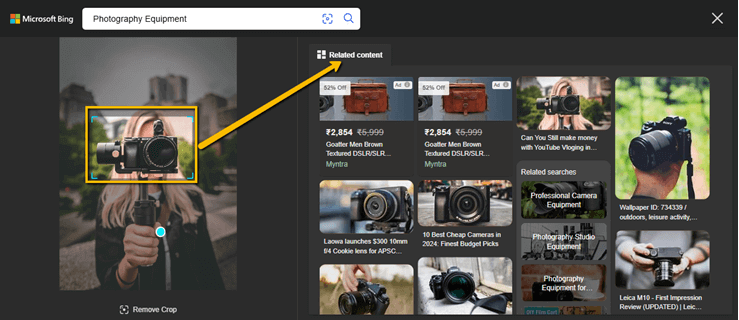
- It integrates with the Microsoft ecosystem, including Edge and many other tools.
- You will also come across filters for relevant searches, such as all images, videos, shopping, news, etc.
Limitations and Drawbacks:
- Sometimes, it provides irrelevant searches. For example, while looking for the supermodel Gigi Hadid, I was shown images of other supermodels, such as Rosie Huntington, etc.

- At times, Bing was unable to find any result, especially if it was a lesser-known person.
- I also noticed that some generic-looking images lead to finding random pictures of people. For example, a photo of a girl with red hair led me to random red-haired people’s images. Hence, I’d suggest using high-quality, unique-looking pictures.
Link: https://www.bing.com/visualsearch?cc=in
4) TinEye
TinEye is a reverse image lookup tool that allows you to upload or enter a URL for a facial recognition check. It also has an API for image verification, mobile image recognition, image tracking, MatchEngine, and more. Users that have a retail business will find its MatchEngine and other tools useful if you want to look up where your products appear.
You can simply use its reverse image or a combination of its products as per your requirement. I personally take the help of its MatchEngine along with reverse lookup to find images that have been manipulated. That’s because if your pictures have been edited, for example, color graded, cropped, watermarked, etc., TinEye will still be able to find them. Hence, it’s great for models or people who are worried about image misuse.
Pricing:
TinEye’s reverse image search is a free app. However, its MatchEngine has monthly charges.
| Starter | Basic | Corporate |
|---|---|---|
| $200 | $500 | $1500 |
How to use TinEye?
Here’s a step-by-step demo of how to use TinEye:
Step 1) First, go to https://tineye.com/ and upload an image or paste a URL. I have uploaded a photo of my subject.
Step 2) Once uploaded, it gave me the results of my input, along with the source links where the image appears.

Advanced Features and Capabilities:
- I could filter my search to find the best match, such as oldest, latest, most changed, and biggest image. It also includes a filter by website and a collection option for precise results.

- TinEye can be added to Chrome as an extension for instant searches with more convenience.
- Its fraud detection capability helps find duplicates, as it can create a unique fingerprint for your images. These fingerprints describe the patterns of the pixels in your photos, which can help identify pictures even with partial matches by reading the pattern. Therefore, parents worried about their kids’ online safety and image misuse can rely on it.
Limitations and Drawbacks:
- Some of the images and URLs that I used did not return any results. This happened even if the image was in the right format. However, you can try converting the picture to other supported formats to see if it works.

- Large images that have pixels above 600 take time to process. That’s because TinEye scales them down to 600 first and then scans them.
Link: https://tineye.com/
5) Berify
Berify is an image verification tool with a robust algorithm that can look up 800 million images. It can verify pictures and videos; hence, I could also look up my video’s thumbnails.
This tool uses mega search engines like Google, Bing, etc., only as supplements, as Berify relies on itself as a proprietary solution.
I could import images from my device, RSS feed, Dropbox, and sitemap, and it allowed me to use website links as well. It is great for legal practitioners, vloggers, reputation management teams, marketing agencies, etc.
Pricing:
Verify is free for up to 5 images.
Here are some of Berify’s lowest monthly plans based on the number of images that you can look up:
| 1000 Images | 6000 Images |
|---|---|
| $5.95 | $24.95 |
Free Trial: It offers a free trial for paid versions for up to 3 days
How to use Berify?
Here are the steps on how I used Berify for facial recognition:
Step 1) Visit https://berify.com/, go to Signup for Free, and create an account with your email ID.
Step 2) Now that you are in your dashboard, go to the Upload Photos option. Then select any option where you want to upload image/images from. Be it social media, your device, a website, etc.
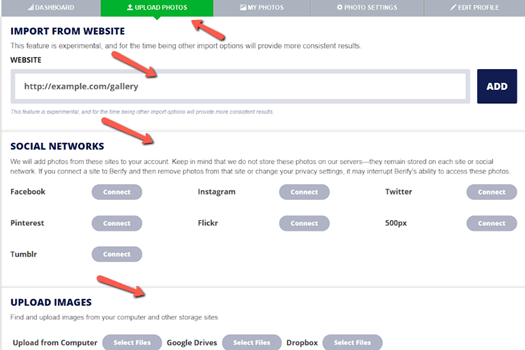
Step 3) After uploading the image from your device, go to the Photo Settings option. You can watch Berify process the image. This may take some time.
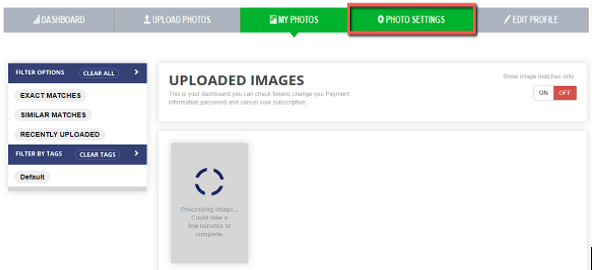
Step 4) Once the search is complete, you can filter and find exact matches, similar matches, and recent uploads of the photo.
Advanced Features and Capabilities:
- It allows bulk upload; therefore, it can look up several photos at once.
- The notification option is quite helpful since I was alerted every time a new duplicate of my image appeared somewhere online.

- Berify does not store your pictures, and you can easily delete the uploaded photos after searches.
Limitations and Drawbacks:
- It is time-consuming when compared to other search tools.

- To check its credibility, I looked up Angelina Jolie’s obviously widely used picture, but Berify failed to return the results. Hence, I suggest cross-checking images on other platforms.
- The tool’s interface may overwhelm the user since it has numerous options but is not always intuitive. I was left wondering where my pictures went after I uploaded them since it didn’t indicate any scanning, and I had to look within the entire tool to figure it out. You will basically have to go to the Photo Settings page to find them if the tool starts lagging.

Link: https://berify.com/
6) SauceNAO
SauceNAO is a simple reverse lookup tool that can locate a similar image online. This is one of the least complex tools that I came across, but it definitely helps you find some of the identical photos.
It helped me upload an image and paste a URL to locate similar images. On SauceNAO, you can select the Safe Search option to avoid coming across explicit results.
Pricing:
It offers a basic free plan, and you can also donate to the creators if you like.
However, here are SauceNAO’s regular monthly plans:
| Pro Plan | Ultra Plan |
|---|---|
| $5 | $20 |
How to use SauceNAO?
A step-by-step on how you can use SauceNAO:
Step 1) Go to https://saucenao.com/ and upload a picture or add a URL of an image.
Step 2) I pasted the URL of an individual in the search bar, and it looked up immediately. I did not use a filter since I wanted to look into a more extensive database. If you know where the image is from, for example, a TV series, you can use a related filter.

Step 3) As you can see here, SauceNAO presented the results based on the similarity order. Therefore, I found the best result, along with the Twitter username and Tweet ID of the person who posted it, on top.

Advanced Features and Capabilities:
- It lets you select the database you want to search from so that you can filter and use a specific source.

- I could find images from TV shows and look them up. Hence, even if some catfishers use a person’s image from some TV show scene, SauceNAO might still be able to identify it.
Limitations and Drawbacks:
- It provides results before it scans the entire database. I learned about this when I looked up a James Bond franchise clip from 2021. To be specific, I even used its Movies filter for the database. It returned results from the early 2000s, 90s, and even as old as the 1930s. Given the fact that James Bond is a well-known franchise and Daniel Craig is quite popular, SauceNAO still failed to pull up the right images.

However, after I posted this same image over 7 times, it finally gave me the correct result.

- It also failed to read a few links. I tested with a link to a well-known image of the most current heartthrob, Jacob Elordi, known for the series–Euphoria, to make it easy for SauceNAO, but it returned unrelated photos.

Link: https://saucenao.com/
Factors That Influence Facial Recognition Accuracy
There are numerous factors that affect the effectiveness of a facial recognition tool. Some of the most common factors include:
- Input Quality: I suggest using high-resolution images since lower quality often results in errors. The expressions on the face, like smiles, frowns, etc., can also add to the challenges. Images with accessories, such as hats, sunglasses, etc., have also hindered my searches.
- Training Data: The larger the dataset used for training, the better. Otherwise, there could be biases, such as a lack of diversity in ethnicities, genders, and ages.
- Algorithm: The algorithm determines how a tool processes the image, which affects the result. A robust algorithm can also adapt to identify facial features such as aging over time.
- Updates: Tools that have developers working to incorporate user feedback for better accuracy also add to facial recognition performance. Hence, apps that update their training dataset consistently perform better.
Security Risks of Facial recognition and their Mitigation
Facial recognition tools have certain security risks that are pretty common; however, I have also found ways to mitigate them:
| Security Risks | Mitigation Measures |
|---|---|
| Privacy violation | • Only use tools that value user privacy • Read the privacy laws thoroughly • Read the terms and conditions, and do not hit “I agree” without being clear |
| Data breaches | • Find out if the tool offers options for “Do Not Store My Images,” “Opt Out,” etc. • Request support for deleting your uploaded images • Try using tools that do not store your data • Steer clear from low-rated tools |
| Lack of Transparency | • If you find a reputable tool that stores your data, read about how user data is stored before using it • Find out what they use your data for • Learn about how images are processed by the tool |
Guidelines for Responsible Use of Facial Recognition Apps
Facial recognition apps are a powerful innovation, but as a user, you must utilize their benefits responsibly. Here are some of the tips on how you can do it:
- Consent: Unless it is a celebrity’s image, your picture, or a dire situation, getting consent from a person is a must.
- Authorization: Make sure to log out of the tool immediately after using it if it requires signing in. Especially if you are using it for business purposes.
- Update App: I suggest regularly updating the app if it is installed on your device. Thus making sure the latest security features are updated.
- Region’s Laws: Be thorough with your region’s laws regarding such tools to avoid any form of violation.
- User Intent: Do not use these tools for your vendetta, for example, to ruin someone’s reputation. For instance, trolling people based on their before and after images if they had some work done.
FAQs
Verdict
After a first-hand experience, I must admit that the above facial recognition tools are quite robust, but they have their limitations. However, my top three recommendations would be:
- Social Catfish: It stood out to me since it included not just similar images but also helped me find several other details about the person in the picture.
- Google Images: This tool is great for locating duplicates, even with accessories on; hence, I loved using Google to locate commercial images.
- Bing Visual Search: Although quite similar to Google, Bing can offer a variety of results, so it is great for cross-checking. Additionally, its cropping tool finds accurate cropped images, which is impressive.








